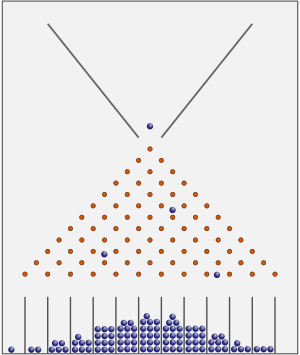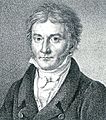Probability facts for kids

Probability is a part of mathematics. It helps us understand how likely something is to happen. It's all about chance and what might or might not occur.
For example, if you flip a coin, there are two possible outcomes: "heads" or "tails". Probability tells us that if you flip it many times, it will land on heads about half the time. It will land on tails the other half.
The chance of an event happening is shown as a number. This number is always between zero and one. Zero means something is impossible. One means it is certain to happen.
Let's say you roll a die. A die has six sides, numbered 1 to 6. The chance of rolling a 1 is 1 out of 6 (written as 1/6). The chance of rolling a 2 is also 1/6. The chance of rolling any number from 1 to 6 is 1. This is because you will always roll one of those numbers.
Probability helps us figure out chances that are not so obvious. For instance, imagine rolling six dice. What's the chance of getting a total number greater than ten? Math helps us solve questions like this.
How to Calculate Chances
One cool thing about probability is how you figure out the chance of two things happening together. You usually multiply their individual probabilities.
Let's use the dice example again. What's the chance of rolling a 3 on one die, then a 5 on another die?
- The chance of rolling a 3 is 1/6.
- The chance of rolling a 5 is also 1/6.
- To find the chance of both happening, you multiply: 1/6 × 1/6 = 1/36.
This means there's a 1 in 36 chance of rolling a 3 then a 5. If you want to find the chance of rolling a 3, then a 5, then a 2, you would multiply again: 1/6 × 1/6 × 1/6 = 1/216. As you can see, the more specific events you want to happen, the lower the probability becomes.
History of Probability
People have thought about probability for a long time. Important thinkers like Gerolamo Cardano in the 16th century studied games of chance. Later, in the 17th century, scientists like Christiaan Huygens, Jacob Bernoulli, and Pierre-Simon Laplace helped develop the ideas we use today. They used the word "probability" to describe how likely events are.
Sometimes, people also think about how often something happens over many tries. This idea is called "frequency probability." It looks at how often an event occurs in a large number of experiments.
See also
Images for kids
-
Gerolamo Cardano (16th century) was one of the first to study probability.
-
Christiaan Huygens wrote an early book on probability in the 17th century.
 In Spanish: Probabilidad para niños
In Spanish: Probabilidad para niños




